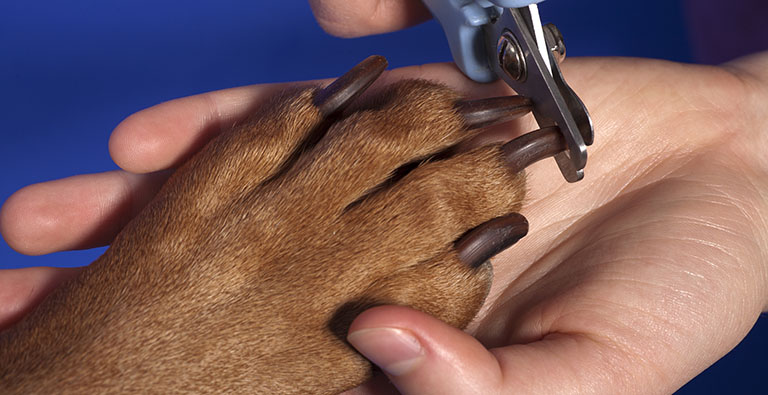The rhythmic tapping of your dog’s long nails against your hard floors may initially seem like a minor inconvenience. However, what many pet owners fail to realize is that overgrown nails can have a major impact on the quality of your dog’s life.
This blog provides insight regarding the recommended frequency for cutting your dog’s nails and explains the often-overlooked consequences of neglecting nail trims. We’ll touch on topics such as damage to joints and tendons, loss of confidence in mobility and the increased risk of injury and infection.
Negative Effects of Neglected Dog Nails
Paw Pad Damage
Dog nails naturally grow in a curved shape. When left unchecked, they can become too long and curl around, growing into the dog’s paw pad. This can lead to a host of problems for the dog. As the overgrown nail punctures through the thick layers of skin covering the pads, it creates an open wound. The dog experiences pain and the wound is prone to developing an infection. Their paw pad may have significant swelling and make walking uncomfortable for the canine. To learn more about paw pad damage from overgrown nails here.
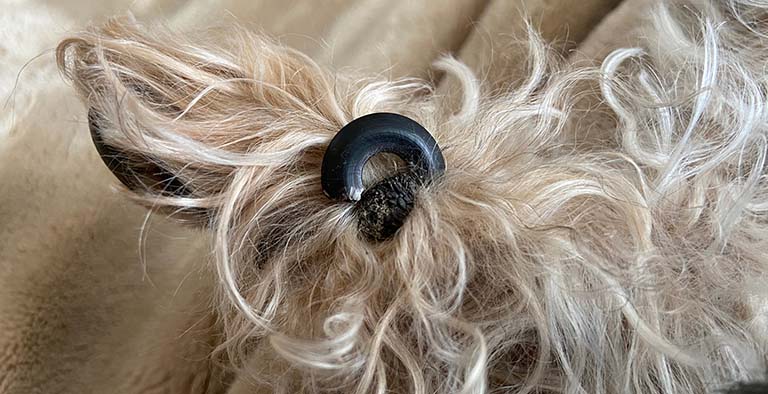
Loss of Traction
Overgrown nails create traction problems for the dog. They may struggle to gain a firm footing on slippery surfaces such as hardwood, tile and linoleum. This lack of grip can instill anxiety and fear, particularly in dogs who are already predisposed to fearful or nervous behaviors. Their lack of confidence in their stability and ease of movement can affect their everyday life. When their fundamental sense of security is compromised, it undermines their sense of independence and leaves them feeling vulnerable.
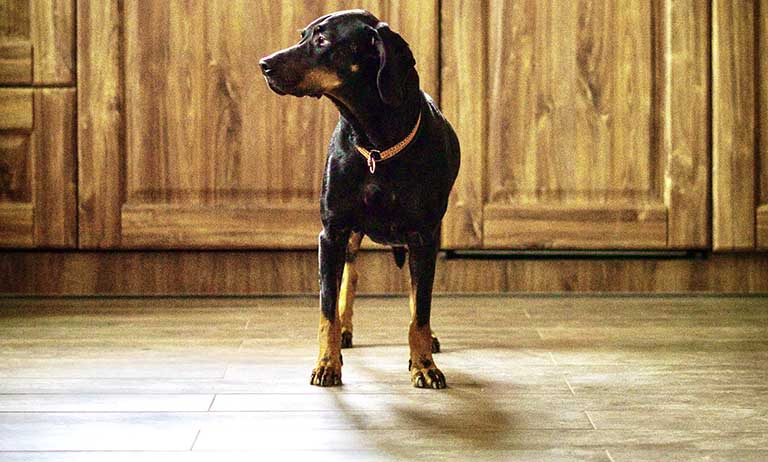
Injuries & Infections
Long nails pose a risk of snagging or becoming entangled in carpets or fabrics. In an attempt to free themself, a dog may accidently tear off the outer enamel of the nail. The exposed sensitive inner tissue then becomes vulnerable to infections. Even minor injuries to this part of the nail can cause considerable pain and discomfort for the dog. The infected part of the claw may show signs of inflammation and swelling. Untreated infections can spread to the surrounding tissues and even bloodstream, posing an even greater threat to your dog’s health.
Damage to Joints and Tendons
A canine’s extended nails pose risks that can potentially result in a range of debilitating issues. From splayed feet to deformed foot structures, the consequences of neglecting nail care can be profound. As long nails make contact with the ground, they exert force on the foot and leg structure, gradually impacting the animal’s musculoskeletal health. Repetition of this action can lead to chronic problems such as arthritis and persistent pain.
The continuous strain imposed on the foot and leg joints may cause wear and tear over time. This can contribute to injuring the tendons, ligaments and supportive structures within the foot and leg. The dog’s physical well-being is affected as the animal may be hindered in their ability to walk and move comfortably.
How Often Should I Trim my Dog’s Nails?
Pet owners often wonder about the right frequency for cutting their dog’s nails. Ideally, dogs should have their nails clipped and filed regularly, typically every 4-6 weeks. At Smoochie Pooch, nail cutting and filing are included in every grooming session as part of our basic package. Pet owners have the option to request both cutting and filling or choose one based on their dog’s comfort level.
If there’s a longer gap between your furry friend’s grooming sessions, you can make the most of your local pet salon’s walk-in services. At Smoochie Pooch, we offer a discounted price for walk-in nail trims every Monday, though we accept walk-ins for nail trims every day we’re open. Click here to learn more about our walk-in nail trims.

Tips to Know Before Trimming Nails at Home
Understanding the Different Parts of a Dog’s Nail
Before attempting to clip your dog’s nails yourself, it’s important to understand the anatomy of a dog’s nail. A canine’s nail has two main parts. The quick is a soft cuticle that contains the blood vessels and nerves that run through your dog’s nail. The shell is the harder outer surface protecting the quick. Cutting a nail too short can result in bleeding, as the nerves in the quick are easily exposed.
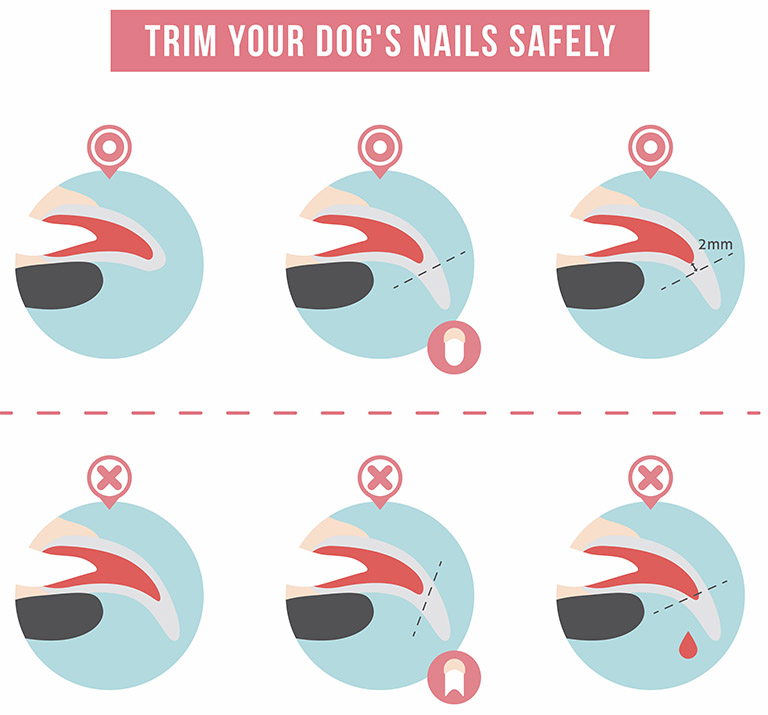
For dogs with dark nails, like rottweilers and giant schnauzers, the task of trimming becomes even more challenging. It’s difficult to visualize the location of the quick through the dark shell. Therefore, extra caution and precision are required to avoid accidentally cutting the sensitive tissue.

To Dremel or Not to Dremel at Home
After clipping the dog’s nails, their claws may sometimes end up jagged. Using a Dremel tool to buff the nails creates smooth, round edges and can help achieve the shortest length possible. Occasionally, nail clippers can exert pressure on the quick, causing discomfort for the dog.
We strongly advise against using a Dremel for nail trimming at home without proper training. Without the necessary expertise, it’s challenging to gauge when to stop or how to use the Dremel effectively. There’s a risk of burning the dog’s nail or trimming too short.
Instead, we recommend seeking the assistance of a professional. Pet groomers have experience and training to ensure a safe and comfortable nail trimming experience for your beloved dog.
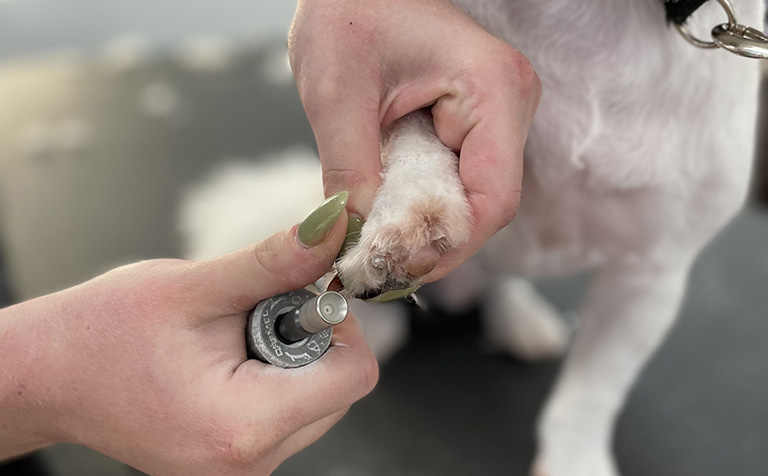
How-To Steps for Cutting Dog’s Nails at Home
- Begin by gently picking up your dog’s paw and placing your thumb on the pad of a toe, with your forefinger on the top of the toe above the nail. This positioning helps extend the nail for easier trimming.
- Clip only the tip of the nail, making sure to cut straight across. Avoid clipping beyond the curve of the nail, as this could result in hitting the quick. The general recommendation is to trim approximately 2 mm away from the quick to avoid causing injury.
- When cutting the nail, be decisive and make a smooth, quick motion while securely holding the nail steady to minimize any potential risks or discomfort for your dog.
Remember to approach trimming your dog’s nails with patience and caution. Creating a positive and stress-free environment can make the process easier and more enjoyable for both you and your canine. If you are struggling or are uncomfortable with doing this service at home, allow your local pet groomer to trim and cut your dog’s nails.

Prioritizing Paw Health
Nail trimming may seem like a mundane aspect of pet care, but neglecting this service can have dire consequences. Overgrown nails can profoundly impact your dog’s quality of life. It can lead to paw pad damage, loss of traction, increased anxiety, injuries, infections and joint and foot issues. Whether you opt to enlist the help of a professional pet groomer or choose to trim your dog’s nails at home, it’s crucial to use the right techniques and stay on a regular schedule for nail cutting. It is best to approach the process with patience, caution and a commitment to your pet’s well-being and overall comfort.


